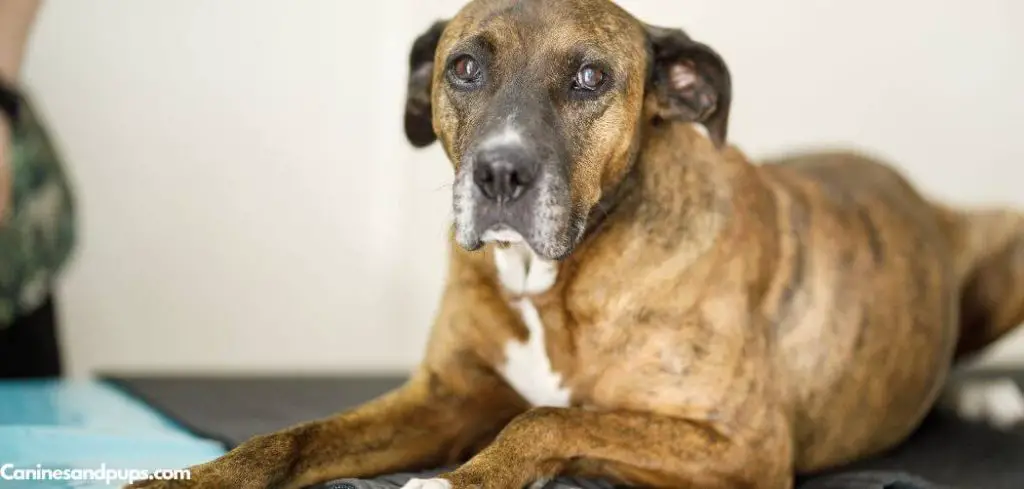Dogs that are panting while simply sitting up can be concerning for owners because this behavior might indicate more than ordinary fatigue or excitement.
While panting is a normal way for dogs to regulate their body temperature, heavy panting without activity, especially when a dog is just sitting, can signal medical issues.
We outline the common reasons why a dog may pant while just sitting up, what you can do at home, and when to seek veterinary help.
Dog Panting and Just Sitting Up — Why It Happens
Dog panting while just sitting up often suggests discomfort, pain, or difficulty breathing. When dogs are in pain—especially from conditions like arthritis, heart disease, or internal issues—they may sit upright to ease pressure on their chest or abdomen.
Panting in this position helps them get more oxygen or cope with stress and discomfort. It can also indicate overheating, anxiety, or the side effects of certain medications.
If your dog consistently pants and prefers sitting up instead of lying down, it’s best to consult a veterinarian to determine the underlying cause and ensure they’re not in distress.

Dog Panting and Just Sitting Up: Common Causes
Stress and Anxiety
Panting while sitting up can often be linked to stress or anxiety. Dogs may remain alert in a sitting position and breathe rapidly when they are anxious or unsettled.
Triggers may include unfamiliar environments, loud noises, new visitors, or separation from their owner.
Other signs of stress can include trembling, whining, or pacing. Recognizing anxiety early can help prevent escalation.
Read more: Dog Panting and Just Laying Around (Here’s why)
Pain or Discomfort
Restless panting while sitting can indicate pain or discomfort. Dogs often try to adjust their posture to relieve internal discomfort, and sitting may be a position that feels least painful.
Other signs of pain include reluctance to lie down, vocalizing, favoring limbs, or sudden behavioral changes. Addressing pain promptly is crucial to prevent further complications.
Heart or Respiratory Issues
Panting while sitting may be a symptom of heart or respiratory conditions. Dogs with heart disease, arrhythmias, or lung problems can experience labored breathing even at rest.
Accompanying signs might include coughing, fatigue, a bluish tongue or gums, or an irregular heartbeat. These conditions require immediate veterinary attention for proper diagnosis and treatment.
Heatstroke or Overheating
Panting while just sitting can be a response to overheating. Dogs regulate body temperature primarily through panting, and even without physical activity, sitting in a warm or poorly ventilated area can cause rapid breathing.
Signs of heatstroke may include drooling, red gums, lethargy, or disorientation. Prompt cooling and hydration are essential to prevent life-threatening complications.
Metabolic or Endocrine Disorders
Certain metabolic conditions, such as hyperthyroidism or diabetes, may lead to panting while sitting.
Hormonal imbalances can increase heart rate and respiration, leaving dogs breathless even at rest.
Other symptoms can include weight changes, increased appetite or thirst, and changes in energy levels. Proper diagnosis and treatment by a veterinarian are necessary to manage these disorders.
Pain or Gastrointestinal Discomfort
Abdominal pain or digestive discomfort can make dogs pant while sitting. Dogs with nausea, bloating, or gastrointestinal distress may adopt a seated position to alleviate discomfort, accompanied by heavy panting.
Additional signs include restlessness, frequent attempts to vomit, or reluctance to move. Identifying and treating the underlying cause is vital to ensure the dog’s comfort and health.
What to Do If Your Dog Is Panting and Just Sitting Up
Create a calm, safe environment for your dog to relax. Offer water and ensure the area is cool and quiet.
Observe for patterns in panting and behavior. Note whether it occurs at specific times, after certain activities, or in response to environmental factors.
Avoid overstimulation and provide gentle reassurance. Speak calmly, pet your dog softly, and allow them to settle at their own pace.
Monitor for other signs of illness, such as lethargy, coughing, vomiting, or behavioral changes. Keeping a diary of these observations can help your vet identify patterns or triggers.
Engage in light, low-stress activities to assess comfort. Gentle walks or brief play sessions may help determine whether panting is activity-related or a resting symptom.
When to Call or Visit Your Vet
Contact your veterinarian if you notice:
Panting that is excessive or persistent without obvious cause
Sudden or worsening restlessness while sitting
Signs of pain, including whining, reluctance to move, or posture changes
Rapid heart rate, labored breathing, or abnormal gum color
Vomiting, diarrhea, or other digestive issues alongside panting
Behavioral changes such as confusion, aggression, or disorientation
Veterinarians can perform thorough examinations, including heart, lung, and blood tests, to identify underlying health problems contributing to panting while sitting.
Read more: Dog Panting and Jumpy (Here’s why)
Key Takeaway
Panting while just sitting up may be normal in certain situations, such as mild excitement or heat, but persistent, excessive, or unexplained panting can signal stress, discomfort, or medical conditions.
Providing a calm environment, monitoring for additional symptoms, and seeking veterinary guidance when needed will help ensure your dog remains healthy, comfortable, and safe.
